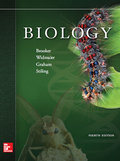
Introduction: Protists are known as the Earth’s first eukaryotes. These eukaryotes are not classified in the plant, animal, or fungal kingdom. Protists are abundant in moist habitats and are microscopic in size. They are informally labeled according to their ecological roles, habitats, and the type of motility.
Answer to Problem 1TY
Correct answer: If an individual is studying the evolution of animal-specific cell-to-cell signaling systems, then the representative species to choose for the observation will be Choanomonada. Hence, the correct answer is option c.
Explanation of Solution
Reason for correct answer:
The Choanomonada belongs to a group of choanoflagellates, which represent the closest living relatives of animals. The evolutionary biologists interested in the origin of animals choose Choanomonada as representative species. These organisms are believed to be the species that have closest association with the multicellular organisms (especially animals). Hence, the representative species to study the animal-specific cell-to-cell signaling system is Choanomonada.
Option c. is given as “Choanomonada”.
Choanomonada are unicellular eukaryotes whose genome is very similar to those of animals. Hence, the correct answer is option (c).
Reasons for incorrect answer:
Option a. is given as, “Rhodophyta”.
Rhodophyta is also known as red algae and they are able to perform photosynthesis. Photosynthesis is a process observed in plants and not in animals. This indicates that Rhodophyta represents a close association with plants. They cannot be used to study the animal-specific cell-to-cell signaling system. Hence, option a. is incorrect.
Option b. is given as, “Discoba”.
Discoba are unicellular eukaryotes with no specific classification. Hence, option b. is incorrect.
Option d. is given as, “Radiolaria”.
Radiolarian lives in an aquatic habitat and they are heterotrophic in nature. They cannot be used to study the evolution of cell-to-cell signaling system as they do not share similarities with the animal cells. Hence, option d. is incorrect.
Option e. is given as, “Chlorophyta”.
Chlorophyta is also referred to as green algae. They contain the same photosynthetic pigments that are present in the plants. Chlorophyta performs photosynthesis and shows a close association with plants and not animals. They cannot be used to study the animal-specific cell-to-cell signaling system. Hence, option e. is incorrect.
Hence, the options a., b., d., and e. are incorrect.
Choanomonada and animals share several genes, and it represents the closest living relative of animals. Hence, it is used as representative species for the animal-specific cell-to-cell signaling studies.
Want to see more full solutions like this?
Chapter 28 Solutions
EBK BIOLOGY
- What are Clathrin coated vesicles and what is their function?arrow_forwardHow is a protein destined for the Endoplasmic Reticulum (ER), imported into the ER? Be concise.arrow_forwardFind out about the organisations and the movements aimed at the conservation of our natural resources. Eg Chipko movement and Greenpeace. Make a project report on such an organisation.arrow_forward
- What are biofertilizers and mention the significancearrow_forwardPCBs and River Otters: Otters in Washington State’s Green-Duwamish River have high levels of polychlorinated biphenyls (PCBs) in their livers. PCBs can bind to the estrogen receptors in animals and disrupt the endocrine system of these otters. The PCBs seem to increase the estrogen to androgen ratio, skewing the ratio toward too much estrogen. How would increased estrogen affect the river otter population? Based on your reading of the materials in this unit, what factors can affect fertility in humans? Explain how each of the factors affecting human fertility that you described can disrupt the human endocrine system to affect reproduction.arrow_forwardOther than oil and alcohol, are there other liquids you could compare to water (that are liquid at room temperature)? How is water unique compared to these other liquids? What follow-up experiment would you like to do, and how would you relate it to your life?arrow_forward
- Selection of Traits What adaptations do scavengers have for locating and feeding on prey? What adaptations do predators have for capturing and consuming prey?arrow_forwardCompetition Between Species What natural processes limit populations from growing too large? What are some resources organisms can compete over in their natural habitat?arrow_forwardSpecies Interactions Explain how predators, prey and scavengers interact. Explain whether predators and scavengers are necessary or beneficial for an ecosystem.arrow_forward
- magine that you are conducting research on fruit type and seed dispersal. You submitted a paper to a peer-reviewed journal that addresses the factors that impact fruit type and seed dispersal mechanisms in plants of Central America. The editor of the journal communicates that your paper may be published if you make ‘minor revisions’ to the document. Describe two characteristics that you would expect in seeds that are dispersed by the wind. Contrast this with what you would expect for seeds that are gathered, buried or eaten by animals, and explain why they are different. (Editor’s note: Providing this information in your discussion will help readers to consider the significance of the research).arrow_forwardWhat is the difference between Uniporters, Symporters and Antiporters? Which of these are examples of active transport?arrow_forwardWhat are coupled transporters?arrow_forward
 Human Anatomy & Physiology (11th Edition)BiologyISBN:9780134580999Author:Elaine N. Marieb, Katja N. HoehnPublisher:PEARSON
Human Anatomy & Physiology (11th Edition)BiologyISBN:9780134580999Author:Elaine N. Marieb, Katja N. HoehnPublisher:PEARSON Biology 2eBiologyISBN:9781947172517Author:Matthew Douglas, Jung Choi, Mary Ann ClarkPublisher:OpenStax
Biology 2eBiologyISBN:9781947172517Author:Matthew Douglas, Jung Choi, Mary Ann ClarkPublisher:OpenStax Anatomy & PhysiologyBiologyISBN:9781259398629Author:McKinley, Michael P., O'loughlin, Valerie Dean, Bidle, Theresa StouterPublisher:Mcgraw Hill Education,
Anatomy & PhysiologyBiologyISBN:9781259398629Author:McKinley, Michael P., O'loughlin, Valerie Dean, Bidle, Theresa StouterPublisher:Mcgraw Hill Education, Molecular Biology of the Cell (Sixth Edition)BiologyISBN:9780815344322Author:Bruce Alberts, Alexander D. Johnson, Julian Lewis, David Morgan, Martin Raff, Keith Roberts, Peter WalterPublisher:W. W. Norton & Company
Molecular Biology of the Cell (Sixth Edition)BiologyISBN:9780815344322Author:Bruce Alberts, Alexander D. Johnson, Julian Lewis, David Morgan, Martin Raff, Keith Roberts, Peter WalterPublisher:W. W. Norton & Company Laboratory Manual For Human Anatomy & PhysiologyBiologyISBN:9781260159363Author:Martin, Terry R., Prentice-craver, CynthiaPublisher:McGraw-Hill Publishing Co.
Laboratory Manual For Human Anatomy & PhysiologyBiologyISBN:9781260159363Author:Martin, Terry R., Prentice-craver, CynthiaPublisher:McGraw-Hill Publishing Co. Inquiry Into Life (16th Edition)BiologyISBN:9781260231700Author:Sylvia S. Mader, Michael WindelspechtPublisher:McGraw Hill Education
Inquiry Into Life (16th Edition)BiologyISBN:9781260231700Author:Sylvia S. Mader, Michael WindelspechtPublisher:McGraw Hill Education





